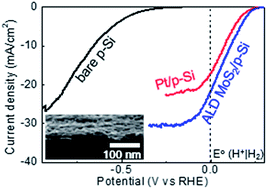Atomic layer deposited molybdenum disulfide on Si photocathodes for highly efficient photoelectrochemical water reduction reaction†
Abstract
Molybdenum disulfide (MoS2) is an earth-abundant and low-cost hydrogen evolving electrocatalyst that can substitute noble metal catalysts. Atomic layer deposition (ALD) is a reliable and scalable process where MoS2 nanomaterials grow directly on Si with a precise film thickness and composition. Here, we demonstrate high-performance Si photocathodes with MoS2 cocatalysts using ALD for the photoelectrochemical (PEC) water reduction reaction. While the morphology and thickness of MoS2 is controlled by ALD reaction cycles, post-sulfurization at high temperatures is conducted to form stoichiometric MoS2 and dramatically enhances the crystallinity of MoS2 to maximize the catalytically active edge sites of basal planes. A systematic study was performed to investigate the role of ALD and post-sulfurization parameters on PEC performances of MoS2 on Si photocathodes. By optimizing the crystallinity, edge site density, stoichiometry, and morphology of MoS2 for maximum electrochemical HER performance and minimum optical and electrical losses, our Si photocathodes with ALD-MoS2 cocatalysts showed reduction of an overpotential of about 630 mV compared to bare Si. The photocathodes also showed a saturating photocurrent density of 31 mA cm−2 without noticeable degradation during a 24 hour stability test in 0.5 M H2SO4 under a simulated 1 sun illumination.


 Please wait while we load your content...
Please wait while we load your content...